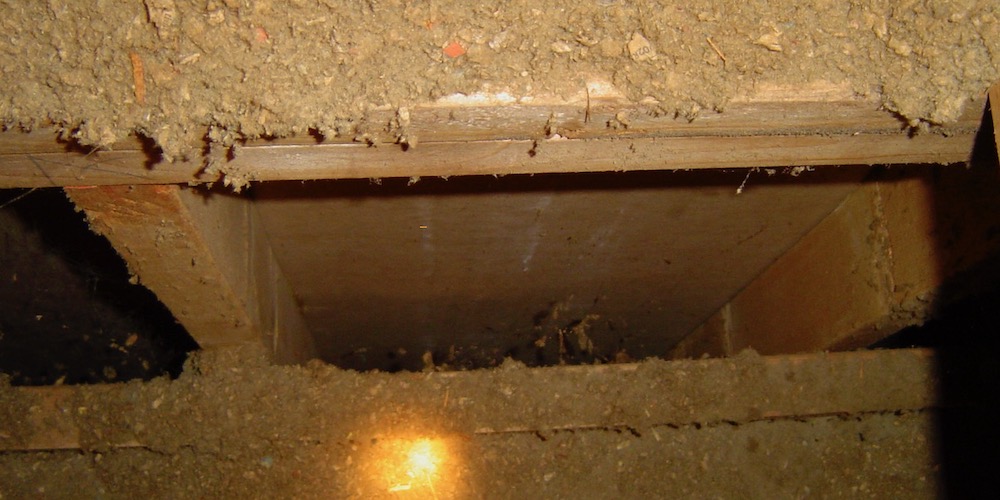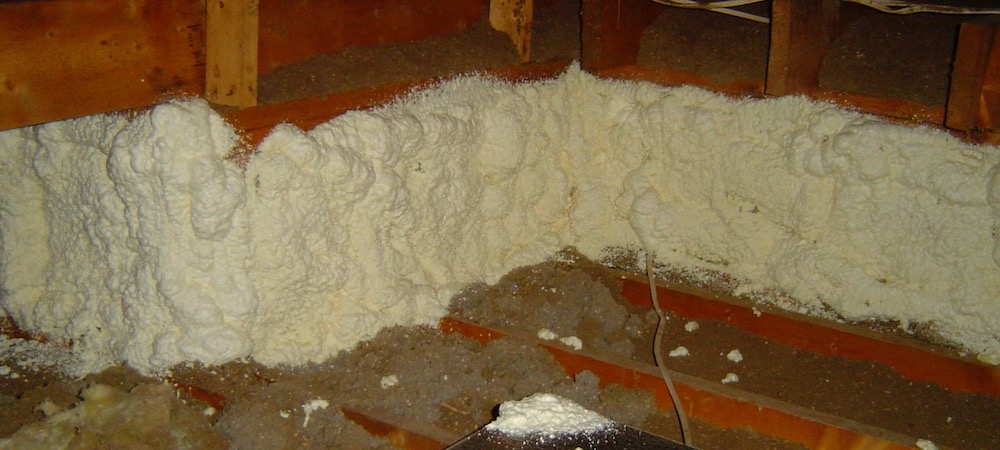How To Install Attic Insulation Video
Dorsum in my home-functioning contracting days (2004 to 2007), I spent a lot of time in unconditioned attics and crawlspaces. First, I was there to detect problems. Then, if the homeowners hired me, I'd go in and do air sealing, insulating, duct sealing, duct repairs, crawlspace encapsulation, and sometimes other jobs. The photo above shows one of the many problems I establish and fixed in a business firm in the Atlanta area in 2006. In the living space below the attic, there was a change in ceiling height, resulting in a short attic kneewall. Every bit you lot can see, it is uninsulated. That, nevertheless, isn't the just problem.

Multiple problems with short attic kneewalls
When you expect closer at those curt attic kneewalls in the photo just in a higher place, you can meet they're open all the way downward to the bottom plates of the wall. That makes what should be an interior partition wall worse than an exterior wall. The exterior walls in this 1987 firm were insulated, and they separated the conditioned infinite from outdoor air.
The attic, on the other manus, gets almost equally cold as outdoors in winter and much hotter than outdoors in summertime. The cranium air extends down into those empty wall cavities, stealing heat from the house in winter and diggings the surrounding rooms with radiant heat in summer. The temperature of those walls will affect the overall hateful radiant temperature, making the occupants uncomfortable.
Those walls likewise allow air leakage between the conditioned space and the attic. Conditioned air from the house can leak into the attic through cracks nether the baseboards, leaky switches and outlets, and other penetrations or unsealed air-leakage points. The likely consequence of that air leakage into the attic is damp, moldy air from the crawlspace getting sucked into the house. The air could also leak in the other direction, with cranium air leak into the house. In either instance, the indoor air quality of the firm suffers.
Thus, the unabridged peak of those walls—the brusk attic kneewall above the lower ceiling and the segmentation wall beneath—nowadays rut flow, air leakage, indoor air quality, and comfort problems. And there'southward a tertiary problem, too, which I'll describe below.
My fix for the kneewalls
My visitor did a lot of piece of work on this house, in both the attic and the crawlspace. To prepare the brusk attic kneewalls, I knew they needed to exist insulated, of course. But they also needed to block attic air from getting into the lower office of those walls. Simply putting fiberglass, mineral wool, or cellulose insulation in the kneewall cavities would be inadequate.
The photo beneath shows my solution. What you see is airtight-cell spray-cream insulation on the short cranium kneewalls. Earlier I sprayed the foam, though, I put fiberglass-batt insulation in the kneewall cavities. The spray cream on the outside of the fiberglass keeps air out of those walls, making the lower part of the walls simple interior partitioning walls once again.
Yous may be wondering if I put blocking into the wall cavities before installing the brusk fiberglass batts. I wonder that, as well. That would be a good chugalug-and-suspenders approach to ensure no attic air can find its way down into the cavities. I don't take photos of that stage, though, nor practice I recall if I did that.

A meliorate gear up
When I posted the lead photograph on LinkedIn a few days ago, Houston home builder Dave Yelovich gave his solution for fixing the wall:
High-density R-xv batt in the kneewall after sealing whatsoever gaps. Install OSB over information technology and run it 16 in. above the top plate to create insulation dams. Add together some blown-in over the peak.
After I stock-still the kneewalls (and air-sealed the attic chases, tin can lights, and all the other air leaks we could observe, as well as doing some duct repairs), I brought in my cellulose-blowing machine and filled the attic with a whole lot of cellulose insulation. Dave mentioned running the OSB (oriented strand lath) up higher than the top of the short kneewalls to create an insulation dam. He sent me the photo beneath to show how they practice it.
![An attic kneewall sheathed with OSB and extended upward to create an insulation dam [Photo credit: Dave Yelovich, Tilson Homes]](https://www.energyvanguard.com/wp-content/uploads/2021/07/attic-kneewall-osb-sheathing-insulation-dam.jpg)
That's the problem that my fix missed. I did blow a whole lot of cellulose above and against those kneewalls, so I got insulation on peak. Without an insulation dam, however, it was subject to falling down to the lower level.
The only thing I'd do differently than Dave is get more insulation in the kneewalls. Georgia requires R-18 minimum in cranium kneewalls, and R-15 with OSB capsule wouldn't see the code. In new structure, I'd frame the kneewall with 2x6s and put an R-19 batt in the cavities (which would provide about R-eighteen because of compression). With existing ii×iv walls, I'd put R-thirteen or R-15 in the cavities then sheathe with foamboard for the extra R-value on the kneewalls.
These fixes, of form, aren't the only possibilities. As long as the attic remains unconditioned, whatever solution would have to address both the air barrier and the insulation, the control layers for air and rut. A bigger (and more expensive way) to solve the problem would be to condition the attic past putting the control layers at the roof line.
No matter how you make up one's mind to address attic kneewalls, the best arroyo is to think like a edifice enclosure control freak.
_________________________________________________________________________
Allison Bailes of Atlanta, Georgia, is a speaker, writer, building science consultant, and the founder of Energy Vanguard. He has a PhD in physics and writes the Energy Vanguard Web log. He is also writing a book on building science. Yous can follow him on Twitter at @EnergyVanguard.
Source: https://www.greenbuildingadvisor.com/article/how-to-insulate-a-short-attic-kneewall
Posted by: danielpokinklant1959.blogspot.com


0 Response to "How To Install Attic Insulation Video"
Post a Comment